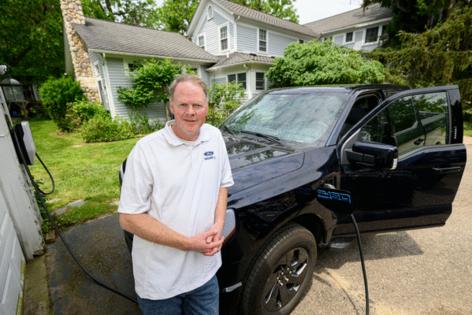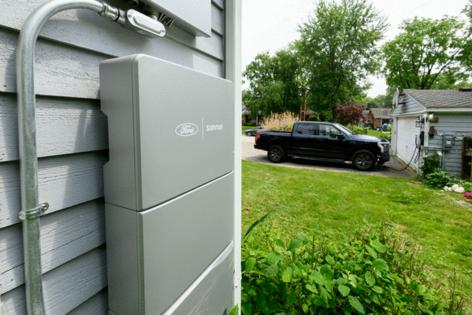More EVs will support homes during power outages, add energy grid capacity
Published in Business News
Some homeowners are looking to electric vehicles to solve their power outage problems this summer.
Automakers increasingly are launching EVs equipped with the ability to support bidirectional charging. The technology can allow energy from the vehicle's battery to be directed to power a plugged-in device, to restore power to a home or to return power to the electrical grid. In addition to being a benefit of EV ownership, it could be a revenue generator for customers and help support a robust electrical grid, particularly at times of peak energy demand and as data centers and artificial intelligence increase electrical needs.
Leveraging the capabilities of these virtual power plants, however, could set up a battle with the U.S. energy sector. A recent report from solar company Wolf River Electric studying the Event-correlated Outage Dataset in America found Michigan had the most major power outages of U.S. states during the summer months from 2019 to 2023.
Tim Addison, 41, of Northville Township, Michigan, is evaluating EV options with bidirectional charging after recently losing his power. It'd been nearly a year since he lost power, but before that, he'd experienced multiple stretches of a couple days without electricity. It's especially a problem because Addison's mother-in-law who lives with his family relies on an oxygen machine. When the house loses power, the family has to go to his mother's house or a hotel.
He evaluated a $15,000 to $20,000 home generator as well as energy storage systems, but bidirectional charging looks like the best option for him: "It seems like it makes more sense than having a battery or a Generac you use 10 days out of a year."
He's disappointed in how few EV models are capable of bidirectional charging now, but he also feels some pressure potentially to make a decision on a vehicle soon with the "One Big Beautiful" reconciliation budget bill in Washington expected to remove a tax credit of up to $7,500 for EV purchases.
"The moment I know the tax legislation is going through, that’s when I have to pull the trigger," the tax attorney said. "It just becomes a little bit more expensive."
He knows his family also will have to figure out transportation needs if the EV is powering his home.
Ryan O’Gorman, 51, of Beverly Hills, Michigan, who owns a 2025 F-150 Lightning, says he'll typically use another one of his family's vehicles if he needs to leave while using the bidirectional charging capability of his truck.
"Typically the concern is the refrigerator or freezer, and that it'll thaw," said the energy services manager at Ford. "But that takes hours. So long as you're not going out of town, you're probably fine."
About a year ago, O'Gorman used his truck for a three-day power outage at his 1845-built, 3,700-square-foot home, where he loses power a few times a year. It was cool enough where the house didn't need air conditioning, he said, but still, there was power left over in the vehicle.
"It took a minute to turn on, but after a couple of hours, you forget it's running off the truck," he said. "The kids were on their phones. We were cooking and doing everything we normally do."
Vehicle-to-home
Ford Motor Co. in 2022 announced a partnership with solar company Sunrun and claimed to be the first to allow Americans to power their home with their truck. The extended-range model of the F-150 Lightning is capable of powering the average house for three days and up to 10 days with rationing or solar power. The pickups start at $63,345.
By 2026, all of General Motors Co.'s EVs will be able to send energy to a residential home (called vehicle-to-home, or V2H) when paired with a GM Energy Home System.
"Our commitment to an all-electric future," GM spokesperson Sanaz Marbley said in an email, "is focused not only on delivering a world-class portfolio of electric vehicles, but investing in the EV ecosystem that will enable mass adoption."
Chrysler parent Stellantis NV's delayed electric trucks — the Ram 1500 REV and Ramcharger — also have bidirectional charging capability. And the Ramcharger has a 130 kilowatt generator on board, which the company says is close to the power of 10 home generators.
Supporting the ability to power a home requires an integration system that converts energy from the truck into power that can be used by the home and connects into the main electrical panel where the grid feeds electricity to the house. The integration system Ford developed with Sunrun costs $3,895 at retail, and installation can be at least another $1,000 more, said Dave McCreadie, a Ford leader in EV-to-grid integration strategy and business development.
Programs like Ford's Power Promise that covers the cost of the standard installation of a Level 2 home charger for buyers of a new EV doesn't include the integration system. McCreadie said Ford's system is built to be competitive with Generacs, but unlike a natural gas-powered generator, the EV solution is silent.
Generac spokesperson Jonathan Stern in a statement said bidirectional charging remains in its infancy, and some homeowners will prefer a traditional generator to keep their EV charged and ready to get to safety, if needed.
“We firmly believe that homeowners won’t trade mobility for resiliency," he said. "If they are experiencing a power outage due to a severe weather event such as a hurricane, storm or wildfire, depleting your vehicle’s battery to power your home could potentially put evacuation plans at severe risk."
Customers of bidirectional chargers can also consider full interconnection. This technology feeds energy back into the grid (vehicle-to-grid, or V2G). McCreadie said it would require a software update and an interconnection agreement with a customer's utility. Not all vehicles with V2H capabilities also support V2G.
"These batteries (in EVs) are so large, and the typical driver is only using a fraction of it every day," McCreadie said. "That leaves a lot left over to potentially put to good use for grid needs."
That includes days when the power from the grid is flowing, but an EV owner could opt to power their home from their charged-up EV from overnight. They might do this to lower their bill, since electricity prices often are cheaper at night than during the day when there is more energy demand. Ford did a demonstration of this last year in Maryland.
"A customer," McCreadie said, "can end up saving tens or dozens of dollars, even maybe as much as $100 per month in an extreme case on their electricity bill."
V2G
Interconnection also could allow electricity from plugged-in EVs to be sent back to the grid, similar to when residential solar panels produce more energy than is required by a homeowner. In return, a utility might offer an incentive or pay a rate to the EV owner for the electricity that could show up on their bill.
Few utilities, however, currently offer these kinds of programs. The state of California is incentivizing bidirectional export compensation, and PG&E Corp., one of the country's largest electrical companies, is offering programs to support that.
Detroit-based DTE Energy Co. says it's working with major automakers on bidirectional charging and is testing V2G technology with electric school buses since they typically are available when utilities need energy the most: during peak summer afternoons when demand is greatest.
"This is an exciting, emerging technology that is still quite early in the development stage," spokesperson Ryan Lowry said in a statement. "As V2G technology matures, DTE will continue testing applications on the grid while expanding integration efforts, including evaluating export compensation, rate design, and tariffs to support customer participation and grid reliability."
Michigan's largest electrical utility, CMS Corp.'s Consumers Energy, says since bidirectional charging technology isn't yet affordable or widely available for most customers, it doesn't offer any customer incentives.
"Consumers Energy is committed making EV ownership convenient and affordable," spokesperson Brian Wheeler said in statement, "and we can see a point in a few years where we might play a role to support bidirectional charging as a benefit to customers and the grid."
McCreadie said Ford is involved in efforts to lobby for these kinds of programs to residential customers.
"There's a whole long story that has to do with net energy metering, and some of the battles that have been waged on what that export rate should be," McCreadie said. "And I think some similar things are happening or going to be happening right now with EVs."
He added that power companies are motivated to offer these kinds of programs because peaker power plants that only operate during times of high energy demand are expensive and capital-intensive. Virtual power plant remedies like bidirectional charging eliminate some of the need to invest in more of those forms of generation.
Collaboration for expansion
A couple recently announced collaborations seek further development in this area. One is ChargeScape LLC, a joint venture among Ford, BMW AG, Honda Motor Co. Ltd. and Nissan Motor Co. Ltd. whose software platform connects EV customers with utilities and automakers, and Leapfrog Power Inc. that does business as Leap. Working together is expected to help automakers obtain information on grid demand and rates to leverage EVs as revenue-generating grid assets efficiently and at scale starting in California and expanding nationwide.
The key to that is improving utilities' comfort with interconnection, which could unlock revenue earnings for EV owners of five to 10 times on an annual basis of V2H applications, Leap CEO Jason Michaels said.
"There's incredible demand for this, especially if you look at the data centers that are expected to be interconnected," Michaels said. "You're talking about adding something that's equivalent to the entire state of California during the hottest heat wave in terms of load onto our grid. There's just not enough new generation that's available. Gas power plants can't be stood up in time to do it. Even solar and wind can't be deployed fast enough to meet that need.
"There's a real need," he continued, "for this capacity to be participating in the grid, providing support and enabling load growth. And we need that load growth to help drive our economy, win the AI battle, have data centers and other things."
Also last month,EV charger supplier ChargePoint Holdings Inc. and power management company Eaton Corp. plc announced a partnership toward creating a one-stop solution for EV charging equipment that supports bidirectional charging.
"To make charging more accessible, you need access to charging infrastructure," Paul Ryan, Eaton's general manager of energy transition, said about addressing a major challenge to EV adoption. "You need more charges, whether that's on public corridor highways or in the homes. So, we need to be able to streamline this so it shouldn't be complicated. This partnership is focusing on innovation, streamlining installation and improving reliability."
Hossein Kazemi, ChargePoint's chief technology officer for hardware, noted helping the country turn to EVs could double grid capacity in North America.
"As the EV adoption continues," Kazemi said, "the need for the power from the utility is going to go up, and at some point, definitely the grid interactive features are going to be very important to have on the chargers."
©2025 www.detroitnews.com. Visit at detroitnews.com. Distributed by Tribune Content Agency, LLC.















Comments